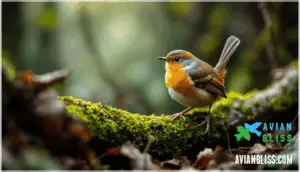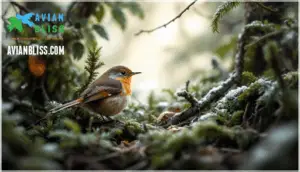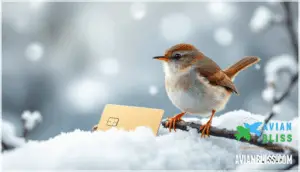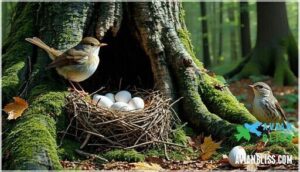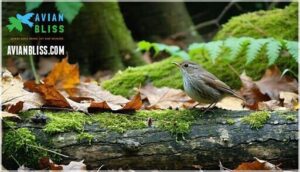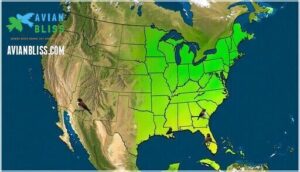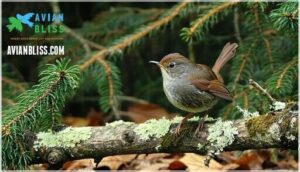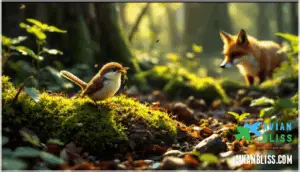This site is supported by our readers. We may earn a commission, at no cost to you, if you purchase through links.

Despite its small size, the winter wren packs impressive adaptations into its compact frame. Its stubby tail stays cocked upright like a miniature flag, while its thin curved bill probes deep into bark crevices for hidden prey.
You’ll find this secretive species in dark coniferous forests across North America, where it hops methodically across the forest floor. Understanding its unique characteristics helps you identify and appreciate one of our continent’s smallest woodland residents.
Table Of Contents
- Appearance and Identification of The Winter Wren
- Habitat and Behavior of The Winter Wren
- Breeding and Reproduction of The Winter Wren
- Diet and Food Sources of The Winter Wren
- Distribution and Range of The Winter Wren
- Taxonomy and Subspecies of The Winter Wren
- Conservation Status and Threats to The Winter Wren
- Vocalization and Calls of The Winter Wren
- Winter Wren Ecology and Interactions
- Winter Wren Research and Conservation Efforts
- Frequently Asked Questions (FAQs)
- What is the difference between a winter wren and a house wren?
- Where are Winter Wrens found?
- Is the Winter Wren endangered?
- Is Winter Wren same as Pacific Wren?
- How long do Winter Wrens live?
- What is the Winter Wrens wingspan?
- Do Winter Wrens migrate in flocks or alone?
- How do Winter Wrens defend their territory?
- What is the Winter Wrens role in its ecosystem?
- How long do Winter Wrens typically live?
- Conclusion
Appearance and Identification of The Winter Wren
You’ll recognize a Winter Wren the moment you see one hopping through the underbrush. This tiny bird has a round, ball-like body and a stubby tail that often sticks straight up like an exclamation point.
Here’s what to look for when identifying this energetic little forest dweller.
Physical Description
If you spot a Winter Wren in the wild, you’ll notice right away that it looks like a tiny, feathered ball with a stubby tail that points straight up. Its plumage features rich rufous-brown tones with darker barring across the wings and flanks, plus a pale eyebrow stripe.
Key physical traits include:
- Compact, round body proportions with short neck
- Stubby tail held erect in characteristic posture
- Thin, slightly curved bill morphology
- Barred wing and tail feathers for camouflage
Distinguishing Features From Similar Birds
While it shares the wren family name with its more familiar cousin, the House Wren, the Winter Wren has a few telltale features that set it apart once you know what to look for.
You’ll notice its shorter, stubbier tail and heavier dark barring on the flanks—both clear visual differences from House Wrens. The plumage also shows richer rufous tones compared to the grayer House Wren.
Listen closely for song differences too: the Winter Wren delivers a long, cascading trill that’s far more musical than the House Wren’s chattering.
While habitat overlap occurs in some regions, behavior contrasts help with Winter Wren identification—it will skulk lower in dense undergrowth.
Size and Measurements
Once you’ve picked out those distinctive field marks, you’ll want to know just how small "small" really is—and the Winter Wren doesn’t disappoint. This tiny bird measures roughly 3.1 to 4.7 inches in length, with a wingspan spanning 4.7 to 6.3 inches. Weight fluctuation stays minimal at just 0.3 to 0.4 ounces—lighter than two pennies. Sexual dimorphism is virtually absent; both sexes share identical measurements and plumage correlation, making size variation subtle across individuals.
Why these measurements matter to you:
- Length of a credit card – At four inches, it’s shorter than your typical bank card
- Wingspan smaller than your palm – Those short, rounded wings explain its weak, fluttering flight
- Weight of a few jellybeans – You’d barely feel one in your hand
- No size difference between males and females – Measurement techniques won’t help you tell them apart
- Shape matters more than size – That stubby tail and round body are your best identification clues
Habitat and Behavior of The Winter Wren
Winter Wrens are creatures of habit regarding where they live and how they spend their days. These tiny birds prefer specific environments for nesting and feeding, and their behavior changes with the seasons.
Let’s look at the key aspects of their habitat preferences and daily routines.
Preferred Nesting and Foraging Environments
If you’re looking for the Winter Wren, start with the darkest, thickest patches of forest you can find. These birds favor mature coniferous and mixed forests with dense undergrowth near water sources. Nest sites are usually tucked into natural cavities close to the ground—upturned roots, stumps, or rock crevices. For foraging microhabitats, they prefer streambanks, tangled brush piles, and decaying logs where invertebrate prey hides in abundance.
Environmental factors like moisture and resource availability shape their habitat partitioning. You’ll rarely spot them above knee height—they’re ground-dwelling specialists through and through.
| Habitat Feature | Nesting Behavior | Foraging Behavior |
|---|---|---|
| Dense forest floor | Cavities in roots/stumps | Leaf litter inspection |
| Streambanks | Low, concealed nest sites | Water’s edge hunting |
| Fallen logs | Natural shelter spaces | Bark crevice probing |
Migration and Overwintering Patterns
When fall arrives, most Winter Wrens migrate south at night, usually peaking in late September through October. Their migration journeys take northern breeding populations to southeastern United States wintering habitats, though some coastal groups stay put year-round.
Climate effects play a huge role—severe winters cause sharp population declines, while milder conditions let birds overwinter closer to their breeding range. Geographic variation shows up clearly: birds in Nebraska and similar regions use warm microhabitats successfully, demonstrating flexible winter habitat selection shaped by local conditions.
Recent data indicates a concerning population decline trend for Winter Wrens.
Foraging and Feeding Habits
When you’re barely bigger than a thumb, every meal becomes a high-stakes treasure hunt. Winter Wrens display striking insect consumption, hopping close to ground level through dense undergrowth. Their insect diet drives constant prey selection as they inspect bark crevices and decaying logs. Streambank foraging provides access to aquatic invertebrates, while seasonal berries supplement their insectivorous lifestyle during fall and winter.
Winter Wren feeding habits include:
- Slow, methodical hopping along forest floors and fallen timber
- Probing moss-covered rocks and root tangles for beetles and spiders
- Gleaning caterpillars and ants from low vegetation and twigs
- Foraging heights rarely exceed three feet above ground
- Capturing prey from water surfaces along stream edges
Movement and Flight Characteristics
Despite their seemingly fragile build, Winter Wrens rarely rely on sustained flight, preferring instead to mouse through tangled undergrowth with explosive bursts of wing-powered movement. Their flight patterns consist of short, whirring dashes between cover—rarely exceeding 15 feet.
Wing morphology favors maneuverability over distance, enabling rapid ground movement through dense territory. You’ll notice agility tactics that include vertical climbing along bark and hopping distances of mere inches as these birds navigate their foraging habitat with mouse-like stealth.
Breeding and Reproduction of The Winter Wren
Winter Wren breeding follows a unique pattern that might surprise you. The male plays an unexpected role early on, while the female makes the final call.
Let’s look at how these tiny birds build nests, lay eggs, and raise their young.
Nest Building and Site Selection
Male Winter Wrens don’t just build one nest—they construct several, giving potential mates a choice of real estate before the female picks her favorite and adds the finishing touches. Here’s what makes their nest-building approach unique:
- Multiple cavity nests built by males in tree holes, rock crevices, or upturned roots
- Natural nest materials like moss, lichens, grass, and leaves woven into dome shapes
- Female involvement completing the chosen nest with soft feathers and hair lining
- Site fidelity to productive territories, with males defending prime nesting locations year after year
Egg Laying and Incubation
After the female chooses her favorite nest from the male’s collection, she wastes no time settling in to lay her clutch of eggs—usually 5 to 7 delicate white ovals marked with subtle reddish-brown speckles. These tiny bird eggs, measuring about half an inch long, concentrate their reddish dots toward the larger end. The female undertakes egg incubation solo for roughly 14 to 16 days, keeping her clutch warm in the cozy nest location while rarely venturing out.
Key incubation facts:
- Egg coloration: White background with concentrated reddish-brown markings
- Clutch size: Usually 5-6 eggs, ranging from 4-7
- Incubation period: 14-16 days of dedicated nesting by the female alone
Parental Care and Fledging
Both parent wrens dive into an around-the-clock feeding marathon once their nestlings hatch, delivering insects and invertebrates to the demanding brood dozens of times each hour. The nestlings develop quickly on this protein-rich diet, their feathers emerging within days. After roughly 19 days in the nest, juveniles take their first wobbly flights but remain close to their parents for continued feeding and protection during the vulnerable post-fledge care period.
| Development Stage | Duration | Key Features |
|---|---|---|
| Nestling Period | 19 days | Rapid growth, parental feeding, feather development |
| Fledgling Phase | 1-2 weeks | Learning to forage, parental supervision, strengthening flight |
Diet and Food Sources of The Winter Wren
The Winter Wren isn’t picky about finding a meal. This tiny bird relies on a varied menu of insects and invertebrates to fuel its energetic lifestyle.
Let’s look at what these wrens eat, how their diet changes through the year, and the clever ways they hunt for food.
Primary Insect and Invertebrate Prey
Through dense forest undergrowth, you’ll hunt a notable diversity of invertebrate prey that fuels your energetic lifestyle. Winter Wren diet reveals elaborate feeding behaviors shaped by microhabitat influence and invertebrate consumption patterns across different habitats.
Your primary dietary arthropods include:
- Beetles (Coleoptera) – representing up to 45% of your prey, these crunchy insects are gleaned from bark crevices and leaf litter
- Caterpillars (Lepidoptera larvae) – comprising 20-35% of meals you deliver to nestlings, these soft-bodied morsels are protein-packed
- Spiders (Araneae) – present in over half of all diet analyses, these eight-legged prey are captured during your methodical ground searches
Beyond insects, you’ll consume flies, ants, millipedes, snails, and earthworms. Insectivorous birds like you demonstrate notable adaptability—decaying logs increase your beetle larva detection by 30%, while dense vegetation boosts spider predation by 22%. They also build nests in a natural cavity.
Seasonal Dietary Shifts
As autumn’s chill settles in and winter’s grip tightens, your dietary strategy shifts with the seasons. Insect availability drops, so you adapt—dietary flexibility keeps you alive when prey abundance changes.
Your seasonal dietary shifts include:
- Spring-Summer – beetles, caterpillars, and spiders dominate your feeding behavior as insects flourish
- Fall – berries supplement your winter wren diet when invertebrates become scarce
- Winter – large pupae, dormant insects, and seeds become critical food sources during harsh months
This dietary flexibility lets you survive year-round in changing habitats.
Foraging Strategies and Techniques
Once you know what a Winter Wren eats, you’ll want to see how it actually hunts down those tiny beetles and spiders hiding in the forest floor. You’ll watch it hop slowly through leaf litter, checking every crack and crevice. It’s an insectivore built for precision—prey detection happens up close as it inspects decaying logs and dense undergrowth.
Habitat selection matters—you’ll find these birds where cover is thick and insects are plentiful. Seasonal foraging adjusts to prey availability, but their feeding behavior stays consistent: slow, thorough, and energy-efficient. Every movement counts when you’re that small.
| Foraging Technique | How It Works |
|---|---|
| Ground searching | Hops methodically through leaf litter, flipping debris to expose insects |
| Crevice inspection | Probes bark gaps and rotting wood where invertebrates hide |
| Low vegetation gleaning | Plucks prey from moss, ferns, and tangled branches near the ground |
Distribution and Range of The Winter Wren
The Winter Wren’s range spans much of North America, though you won’t find these tiny birds everywhere year-round. Their distribution shifts dramatically with the seasons as some populations migrate while others stay put.
Let’s look at where you can expect to encounter Winter Wrens during breeding season, winter months, and beyond their typical range.
Breeding Range in North America
You’ll find Winter Wren breeding across Canada’s boreal forests, Alaska, and northeastern U.S. highlands—a vast 5,430,000 square kilometers supporting roughly 12 million birds. Their nesting behavior ties them to mature forests with dense understory and coarse woody debris. Here’s where breeding territory thrives:
- Northeastern Minnesota and Great Lakes states show highest densities
- Mixed coniferous forests with 40-70% deciduous cover
- Breeding range in North America extends from Alaska to Appalachian Mountains
- Population densities reach 4.2 pairs per 40 hectares in prime habitat
Climate impacts and habitat fragmentation have caused range contractions at southern edges, though forest succession enabled range expansion in reforested New England areas.
Migratory and Overwintering Areas
When temperatures drop and daylight fades, Winter Wrens pack their bags and head south—trading Canada’s forests for the warmer cover of the southern U.S. and Pacific Coast. Migration patterns of the Winter Wren follow photoperiod cues and temperature shifts as migration triggers.
Birds navigate through stopover ecology sites in the eastern U.S., selecting dense thickets and streamside tangles for overwinter survival.
Climate impacts are shifting their geographic range northward, altering traditional habitat selection and breeding range in North America connectivity.
Peripheral and Vagrant Records
Though most Winter Wrens stick to their well-worn paths between Canada and the southeastern U.S., a few adventurous individuals occasionally turn up in unexpected places—proving that even the tiniest birds can have a sense of adventure. These accidental occurrences highlight how migration patterns can shift due to climate influence and habitat changes. Vagrancy records help scientists track range expansion and understand rarity factors affecting geographic range.
Key vagrant sighting locations include:
- Western states beyond typical Pacific Coast wintering areas
- Southern Texas and Gulf Coast regions during severe weather events
- Urban parks far from forested breeding habitat
- Offshore islands during storm-driven displacement
- Agricultural lands where data collection reveals climate change impacts
Bird migration patterns continue evolving as environmental conditions reshape traditional routes.
Taxonomy and Subspecies of The Winter Wren
The Winter Wren’s family tree has a few interesting branches worth exploring. Scientists recently reclassified this species based on genetic evidence, separating it from similar wrens in other parts of the world.
Let’s look at how the Winter Wren fits into the broader wren family and what subspecies you might encounter across North America.
Relationship to Other Wren Species
If you’ve ever wondered where the Winter Wren sits on the family tree of wrens, you’ll find it’s closely tied to two other species that were once considered the same bird.
In 2010, scientists split what was called a single species into three distinct groups based on evolutionary history and wren phylogeny: the Winter Wren, the Pacific Wren, and the Eurasian Wren.
This species divergence reflected genetic differences that had developed over thousands of years, showing how populations evolved separately across different continents and developed unique songs and traits.
Recognized Subspecies and Their Ranges
The Winter Wren isn’t just one bird wearing different coats—it’s actually a cluster of recognized subspecies spread across North America, each adapted to its own slice of forest habitat. Scientists recognize several subspecies showing genetic differences and range variations across the continent:
- Eastern populations inhabit dense coniferous forests from Canada through the Appalachians
- Western subspecies thrive in coastal rainforests and mountain woodlands
- Island populations display unique habitat adaptation features shaped by isolation
Understanding this geographic variation helps target conservation needs for vulnerable populations facing habitat loss.
Phylogenetic Placement Within Troglodytidae
Tucked into the sprawling family tree of Troglodytidae—home to over 80 wren species worldwide—the Winter Wren holds a specific evolutionary branch that researchers have traced through genetic analysis and fossil evidence.
The 2010 species split separated it from Pacific and Eurasian relatives based on genetic evidence revealing distinct lineages. This wren evolution highlights how biogeography shaped ancestral traits, positioning the Winter Wren as a unique member of the avian family tree with identifiable subspecies across North America.
Conservation Status and Threats to The Winter Wren
The Winter Wren faces several challenges that affect its survival across North America. While the species isn’t in immediate danger, certain threats are causing concern among conservationists.
Let’s look at the current status of Winter Wren populations and what’s putting pressure on these tiny birds.
Population Trends and Estimates
You’ll find about 11 million Winter Wrens across North America, but population trends tell a more complex story. Monitoring efforts through breeding bird surveys reveal regional variations, with some areas experiencing population declines of up to 30% over fifteen years.
Habitat loss and climate change drive these shifts, particularly affecting northeastern populations.
Despite these habitat impacts and climate effects, the species maintains stable numbers continent-wide, earning it a low conservation concern score.
IUCN Red List Classification
Despite holding a "Least Concern" status on the IUCN Red List, this classification doesn’t mean Winter Wrens are immune to trouble. Their threat level criteria show regional status variations, particularly in places like New Jersey where they’re listed as a Species of Special Concern. Population decline causes include habitat loss and fragmentation, which affect conservation action impact.
Key factors shaping Winter Wren conservation status:
- Regional differences matter: Some states flag them as vulnerable despite the global "Least Concern" rating
- Habitat quality drives future status predictions: Forest fragmentation threatens breeding success
- Conservation efforts focus on protecting dense understory: Maintaining shrubby forest layers aids their survival
- Population decline causes vary by location: Northeastern populations face steeper drops than western ones
- Threat monitoring continues: Scientists track trends to adjust conservation action impact as needed
Habitat Loss and Fragmentation
Even with a "Least Concern" label globally, habitat loss and fragmentation still chip away at the Winter Wren’s forest strongholds. Urbanization impact and forest fragmentation break up their dense, shrubby understories into smaller patches, causing population isolation.
This habitat degradation makes it harder to spot these birds as breeding success drops. Conservation strategies focused on habitat protection and restoration—like preserving old-growth forests and reconnecting fragmented woodlands—offer hope for reversing declines flagged by the IUCN Red List monitoring.
Climate Change Impacts
Beyond habitat loss, climate change is reshaping the Winter Wren’s future. Range contraction looms large—models predict an 85% loss of current breeding range by 2080. Northern populations show frost resilience, tolerating 70% more frost days than southern birds, but warming winters trigger migration shifts northward.
Population decline already averages -2.56% yearly in the Northeast, driven by:
- Severe winter mortality spikes
- Shrinking summer habitat suitability
- Forced relocation into Canada’s boreal forests
- Unpredictable food availability during breeding
Adaptive responses like larger body mass in colder regions help, but may not match rapid climate shifts. Conservation efforts now prioritize habitat restoration in projected northern refuges, guided by IUCN Red List monitoring and population trends data.
Vocalization and Calls of The Winter Wren
The Winter Wren may be small, but its voice packs a punch you won’t forget. This tiny bird produces one of the most complex and beautiful songs in North American forests, along with sharp calls that help it communicate danger and location.
Though tiny, the Winter Wren fills the forest with a dazzling, unforgettable song and sharp calls that signal both beauty and alertness
Let’s explore how these vocal patterns work and what makes them unique across different regions.
Singing Behavior and Song Characteristics
You might think such a tiny bird couldn’t pack much punch, but the Winter Wren delivers one of the most complex and powerful songs in North America. Their vocalization consists of rapid, high-pitched musical trills and chatters that can last six to ten seconds. Males sing from elevated perches during breeding season, with song dialects varying between regions. This vocal learning helps them attract mates and defend territory through acoustic adaptation.
- Song complexity: A single Winter Wren song contains over 100 notes delivered in rapid succession
- Singing frequency: Males repeat their songs hundreds of times daily during peak breeding
- Vocal learning: Young wrens learn Winter Wren vocalizations by mimicking nearby adults
- Acoustic adaptation: Their high-pitched sounds carry well through dense forest undergrowth
Alarm Calls and Contact Notes
Listen closely in the forest and you’ll hear two distinct sounds from this tiny bird—a sharp "chimp-chimp" alarm when danger lurks, and softer "tit-tit" contact notes as family groups stay in touch. These alarm calls intensify when predators approach, triggering an immediate response from nearby wrens.
The vocalizations show signal complexity with context variations—harsher notes for aerial threats, rapid chattering for ground predators. While Winter Wren song demonstrates individual dialects, their calls remain consistent across populations for effective communication.
Geographic Variation in Vocalizations
From Alaska’s mossy rainforests to the rocky slopes of Appalachia, Winter Wrens have developed distinctly different songs that reflect where they live. These song dialects arise through vocal learning and environmental adaptation, with birds tailoring their melodies to local acoustics. Regional accents help wrens recognize neighbors and attract mates within their territory.
Bird song variation includes:
- Genetic influence shaping basic vocal structure
- Geographic isolation creating unique Winter Wren song patterns
- Environmental factors filtering sound through different forest types
Winter Wren Ecology and Interactions
The Winter Wren doesn’t just survive in the forest—it plays a part in keeping things balanced. From the insects it hunts to the predators that hunt it, this tiny bird fits into a bigger picture. Let’s look at how it connects with the world around it.
Role in Forest Ecosystems
Deep in the forest understory, these pint-sized insectivores punch way above their weight class when it comes to keeping bug populations in check. Their insect control services aid ecosystem health by reducing pest outbreaks that could harm forest habitat. As habitat indicators, their presence signals intact nutrient cycling and a balanced food web. They’re key players in forest management, contributing to overall ecosystem function.
| Ecosystem Role | Impact | Benefit |
|---|---|---|
| Insect control | Reduces pest populations | Protects vegetation |
| Food web participant | Links invertebrates to predators | Maintains balance |
| Habitat indicator | Signals forest quality | Guides conservation |
| Nutrient cycling | Redistributes energy | Supports growth |
| Forest habitat specialist | Uses dense understory | Indicates ecosystem health |
Predators and Nest Competitors
Small, secretive birds like the Winter Wren face constant danger from sharp-eyed hawks, stealthy weasels, and opportunistic house cats prowling the forest floor. Their nesting behavior makes them vulnerable to diverse mammalian threats and avian predators:
- Snakes raid low-lying nests tucked in root cavities
- Squirrels and chipmunks compete fiercely for prime nesting sites
- Domestic cats pose serious survival risks near human habitats
- Owls hunt these tiny wrens during nighttime foraging
Dense habitat provides essential competition avoidance and protection from predators.
Relationship With Humans
Most people never notice Winter Wrens in their backyards, but these secretive forest birds have quietly adapted to life alongside humans—sometimes for better, sometimes for worse. Habitat impact from development pushes them deeper into forests, while citizen science projects help track population shifts. You can support conservation through habitat restoration and joining citizen science efforts:
- Keep outdoor cats indoors to reduce human disturbance
- Preserve dense understory vegetation through thoughtful forest management
- Participate in bird counts to monitor these valuable insect control providers
Their cultural symbolism as hardy survivors inspires ongoing conservation support.
Winter Wren Research and Conservation Efforts
Scientists and conservationists are working hard to protect Winter Wrens and understand their needs. You’ll find ongoing research tracks population changes while conservation groups focus on protecting their forest homes.
Here’s how you can get involved in keeping these tiny birds thriving.
Scientific Studies and Monitoring
Scientists rely on survey methodologies to track Winter Wrens across their range. Breeding Bird Survey protocols in the UK have monitored over 2,600 squares annually since 1994, while Mountain Birdwatch surveys in the Northeast provide annual population trends showing a 30% decline over 15 years. Climate effects hit hard—each additional frost day correlates with a -0.045 population growth rate decline across regions. Regional adaptation studies reveal northern populations tolerate 70% more frost days than southern ones. Data integration combines citizen science observations with biometric measurements and habitat assessments, helping researchers understand how these tiny birds respond to climate change.
| Survey Program | Geographic Scope | Key Findings |
|---|---|---|
| Breeding Bird Survey (UK) | 2,600+ km² squares | Stable 1994–2011; frost sensitivity varies by region |
| Minnesota Breeding Bird Atlas | 16.6% of blocks surveyed | 588,000 adults estimated statewide |
| Mountain Birdwatch | Northeast US forests | 30% decline since 2010 |
| Minnesota Biological Survey | 714 breeding locations | Documents density and distribution patterns |
| National Ringing Programs | UK-wide | Body mass 5% higher in colder regions |
Conservation Programs and Initiatives
Armed with data showing where Winter Wrens struggle most, conservation groups now focus their resources on protecting the habitats these birds can’t survive without. Here’s how habitat conservation efforts unfold:
- Habitat Preservation targets old-growth forests with dense understory
- Population Monitoring tracks breeding success through bird conservation surveys
- Mitigation Strategies reduce building collisions and outdoor cat predation
- Public Awareness campaigns educate landowners about forest management
- Funding Allocation directs resources toward protecting critical migration stopover sites
These coordinated conservation initiatives strengthen habitat protection across the Winter Wren’s range.
Citizen Science Opportunities
If you’ve got binoculars and a few hours to spare, you can become part of the solution. Citizen science opportunities like eBird participation and NestWatch data let you contribute directly to Winter Wren research and conservation efforts. Community monitoring helps scientists track population trends and geographic variation across regions. Your volunteer projects make a real difference:
- Recording Winter Wren sightings during breeding season
- Documenting nest locations and success rates
- Reporting unusual behaviors or habitat changes
Data contribution from observers like you strengthens conservation programs protecting these tiny forest dwellers.
Frequently Asked Questions (FAQs)
What is the difference between a winter wren and a house wren?
Two tiny brown birds can cause confusion, but key differences help you tell them apart. The Winter Wren shows a stubbier tail held upright, bolder barred flanks, and a pale eyebrow line. House Wrens sport longer tails, plainer sides, and lack that distinctive eyebrow marking. Their songs differ dramatically—Winter Wrens deliver rapid, tinkling trills while House Wrens produce bubbly, chattering melodies.
Habitat preferences also set them apart: Winter Wrens favor dense, moist coniferous forests near streams, while House Wrens readily occupy open woodlands, gardens, and nest boxes near human dwellings. Size-wise, Winter Wrens measure slightly smaller at 1–7 inches compared to House Wrens. Though these avian species overlap during migration, careful attention to plumage comparison, behavior contrasts, and song differences makes identification straightforward.
Carolina Wrens, another comparison of bird species worth noting, dwarf both at nearly twice their size with rusty upperparts and prominent white eyebrows, making them easier to distinguish in overlapping ranges.
Where are Winter Wrens found?
Winter Wren habitat and range spans coniferous and mixed forests across Canada, Alaska, and the western US during breeding season.
These forest habitat specialists winter throughout the southeastern US and along the Pacific Coast, with regional differences in seasonal presence and elevation ranges from sea level to 8,000 feet.
Is the Winter Wren endangered?
Habitat loss and forest fragmentation pose the main threat factors to this species, though its Continental Concern Score stands at 8/20, indicating low conservation concern.
Regional status shows population decline since 2012, requiring habitat protection and conservation efforts.
Is Winter Wren same as Pacific Wren?
These two species were once considered the same bird. Genetic evidence led scientists to officially split them in 2010 based on song variation, morphological differences, and hybrid zones where their ranges meet.
How long do Winter Wrens live?
Average lifespan for these tiny birds reaches about five years in the wild, though survival skills against predators and food availability play huge roles.
Mortality causes vary, but many don’t make it past their first year—making each day count.
What is the Winter Wrens wingspan?
You’ll need a magnifying glass to appreciate this bird’s wingspan properly. Winter Wrens have a wingspan of just 7 to 3 inches, making them one of the smallest songbirds you’ll encounter in North American forests.
Do Winter Wrens migrate in flocks or alone?
You won’t find flock dynamics in Winter Wren migration behavior. These birds prefer solitary migration or travel in pairs.
Nocturnal migration lets them slip quietly along migratory routes, reflecting their secretive Winter Wren habitat and behavior.
How do Winter Wrens defend their territory?
You’ll notice territory defense is serious business for these wrens. Males use vocalization defense, singing loud trills to mark territorial boundaries.
Intraspecific aggression includes chasing rivals near nest sites—resource guarding is key in Winter Wren habitat and behavior.
What is the Winter Wrens role in its ecosystem?
Picture a tiny gardener tending a vast forest. By eating insects, spreading seeds, and cycling nutrients, these birds shape the food web.
Their foraging boosts forest health, keeping habitats stable and supporting conservation efforts for many species.
How long do Winter Wrens typically live?
You’ll find that Average Longevity for these birds is about two years, though Maximum Age can reach five.
Lifespan Factors include Survival Rates, food availability, and Predators.
Strong Winter Wren survival strategies help shape Population trends.
Conclusion
You might think spotting a winter wren is too tricky, but patience pays off. Listen for its powerful song echoing through shaded forests, and watch for its darting movements near fallen logs.
Each encounter reveals more about this bird’s secret world—its clever foraging, tiny nest, and unique role in the ecosystem. The winter wren’s presence reminds you that even the smallest creatures shape the forest’s story, rewarding careful observation with glimpses of nature’s quiet brilliance.

